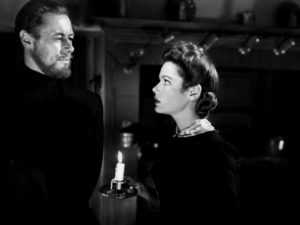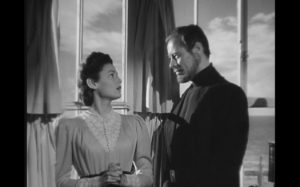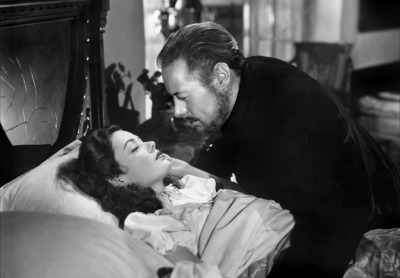By Kari Bowles
Following the success of Alfred Hitchcock’s Rebecca(1940), Hollywood saw a trend toward opulent period pictures dripping with atmosphere for the rest of the decade. Some films, following Hitchcock’s lead, directly channeled nineteenth century Gothic literature, such as Robert Stevenson’s version of Jane Eyre (1944), or George Cukor’s Gaslight(1944). Others were literal ghost stories, such as The Uninvited (Lewis Allen, 1944). The latter film would make a fitting double-bill with The Ghost and Mrs. Muir (Joseph L. Mankiewicz, 1947), as they both feature haunted houses along the English coast around the beginning of the twentieth century. But where The Uninvited had a theme of buried secrets expressed through suggestive spookiness, Mankiewicz’s film has a tone of warm humor as the base for a charming romance. The supernatural in this film is both the stumbling block to its central couple, and an element of their union.
 The film begins with young widow Lucy Muir (Gene Tierney) striking out on her own, refusing to continue living in her in-laws’ stifling household. Against the protestations of the rental agent she rents a seaside abode called Gull Cottage, and moves in with her young daughter Sarah(Natalie Wood, post Miracle on 34th St) and loyal maid Martha(Edna Best). Of course, the cottage is haunted by the ghost of its original owner, Captain Daniel Gregg(Rex Harrison). The brusque, salty apparition is impressed that Lucy isn’t scared off by the shenanigans he’s pulled on previous renters; for her part, she’s excited by something as unique as living in a haunted house. They come to appreciate each other, the Captain dictating his memoirs to Lucy for publication. But of course, nothing is easy when one falls in love with a ghost. Things become even more complicated when a smooth talking author (George Sanders, wonderfully sleazy as usual) sets his sights on Lucy, much to the Captain’s displeasure—“I told you to see men, not perfumed parlor snakes!” he snarls—. But just because he’s alive, does it make him real?
The film begins with young widow Lucy Muir (Gene Tierney) striking out on her own, refusing to continue living in her in-laws’ stifling household. Against the protestations of the rental agent she rents a seaside abode called Gull Cottage, and moves in with her young daughter Sarah(Natalie Wood, post Miracle on 34th St) and loyal maid Martha(Edna Best). Of course, the cottage is haunted by the ghost of its original owner, Captain Daniel Gregg(Rex Harrison). The brusque, salty apparition is impressed that Lucy isn’t scared off by the shenanigans he’s pulled on previous renters; for her part, she’s excited by something as unique as living in a haunted house. They come to appreciate each other, the Captain dictating his memoirs to Lucy for publication. But of course, nothing is easy when one falls in love with a ghost. Things become even more complicated when a smooth talking author (George Sanders, wonderfully sleazy as usual) sets his sights on Lucy, much to the Captain’s displeasure—“I told you to see men, not perfumed parlor snakes!” he snarls—. But just because he’s alive, does it make him real?
Rex Harrison is now best known as Prof. Henry Higgins in My Fair Lady (George Cukor, 1964), and there are a few commonalities between Higgins and Captain Gregg, namely their superciliousness and biting wit. But there are significant differences as well; the Captain possesses a core of warmth and tenderness that would be alien to Higgins. One of the finest scenes in the film is when the Captain declares his love to Lucy while she sleeps, an admission rendered bittersweet by all they did not, and cannot, experience together. Gene Tierney, three years removed from her career-best turn in the dreamlike noir Laura (Otto Preminger, 1944), brings some of the same flavor to her character in this film. Despite her concern with the practicalities of life, Lucy Muir always seems fundamentally removed from it. Tierney’s ethereal presence makes her a fitting match for her ghostly paramour, even while she’s living.
The film is also noteworthy for its musical score, courtesy of the great composer Bernard Herrmann. Herrmann, often associated with the tense scores he produced for Alfred Hitchcock, stated on the record that The Ghost and Mrs. Muir was his personal favorite creation. It is easy to see why: the music manages to balance suspenseful cues with lush romantic strings with ease. By the wholly appropriate conclusion, it is soaring – for the audience along with the film’s couple.





Leave a Reply